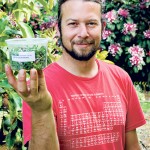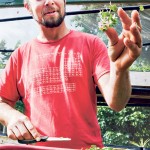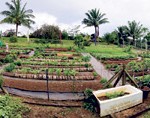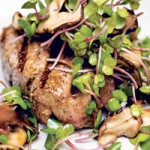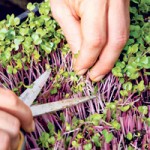Microgreens Are Mega Good
Jaime Means of Shamma Farms grows produce on two properties. One 3-acre parcel has a 5,000-square-foot garden and 2 acres of fruit trees. The other property is 7.5 acres with a 3,000-square-foot garden. Means uses biodynamic techniques that include plantings timed to the lunar calendar, making compost, organic fertilizer (including worm castings), organic pest control, and organic starts from Heaven on Earth Starts.
Means specializes in medicinal food, herbs, micro-greens and garden vegetables.
What’s growing now: Avocados, basil, beets, broccoli, bush beans, cabbage, calamansi, carrots, cassava, chayote, chives (French and garlic), choy, cilantro, coconuts, comfrey, dandelion greens, dragonfruit, edible flowers, egg fruit, eggplant, gourd (curly), grapefruit (sweet), kabocha squash, kale (curly, fizz, rainbow), kumquat, leeks, lemons (Meyer), lemongrass, lettuce, limes (seedless Tahitian), longan, lychee, mangos, marjoram, microgreens, mustard cabbage, neem, noni, onions, oranges, oregano (Greek), parsley, peppermint, perpetual spinach, rosemary, sage, spearmint, tangelo, tangerine, taro, tarragon, thyme, white sapote.
MICROGREENS
Microgreens are baby plants that are one to three weeks old. The difference between sprouts, micro-greens and baby greens isgrowing stages. Sprouts are the initial stage of a seed’s development and are not grown in soil. Microgreens are the second stage of a seed’s development and are grown in soil. This establishes roots and the opening of its first leaves, called cotyledons. If micro-greens are allowed to grow, they put out their next set of leaves, called “true leaves,” and are considered baby greens. Baby greens are tender leaves that are popular in salad mixes, often called mesclun or spring mix.
Microgreens are tender, delicate and highly flavorful. They have a crisp yet melt-in-your mouth texture and a variety of flavors that range from sweet to savory to earthy to spicy. Their vibrant colors of green, red, purple and yellow add an elegant touch to any preparation.
Means grows a variety of microgreens for his 1-ounce blends that are available in health food stores. His mixture includes radish, broccoli, pak choy, red Russian kale, kohlrabi, mizuna and red cabbage. All Shamma Farms microgreens are triple washed.
Season: Microgreens can be grown year-round and grow best in trays in a greenhouse.
What to look for: Choose microgreens with short, stout stems and deep, robust color. Most microgreens don’t have their roots attached because they are cut off when harvested.
Storage: Store in a cool, dry area like the refrigerator. Placing a paper towel over them will help them keep longer. Moisture is good, but too much causes them to deteriorate quickly. Stored correctly, they will last between one and two weeks.
Preparation: Microgreens can be eaten alone as a salad, or added to soups, smoothies, sandwiches, burgers or as a flavor and colorful garnish to entrees.
Health benefits: Microgreens are loaded with nutrients such as digestible vitamins, minerals and phytonutrients. A study published in the Journal of Agricultural and Food Chemistry found that most microgreens had four to six times more nutrients than the mature leaves of the same plant. There were variations, of course – red cabbage was highest in vita-min C, for instance, and green daikon radish had the most vitamin E.
Shamma Farms produce can be found at: Grocery: Means delivers every Tuesday and Friday to Healthy Hut, Hoku Natural Foods and Papaya’s Natural Foods and Cafe. Restaurant: Hukilau Lanai and Akamai Juice Co. For more information or restaurant orders, email meansound@gmail.com.
ASIAN MICROGREEN SALAD
This recipe is adapted from “Microgreens: A Guide to Growing Nutrient Packed Greens” by Eric Franks and Jasmine Richardson. The salad is wonderful on its own, but atop grilled beef, chicken, fish or tofu, it’s a fresh, savory meal. Makes six servings.
* 1-inch knob fresh ginger plus 2 teaspoons grated ginger, divided
* 1/2 cup plus 2 tablespoons soy sauce, divided
* 1/4 cup plus 3 tablespoons canola oil, divided
* 1/2 cup brown sugar
* 2 tablespoons rice wine vinegar
* 1 teaspoon honey * 1 tablespoon sesame oil
* 2 cups sliced shiitake mushrooms, sautéed and cooled
* 7 ounces microgreens
Crush ginger knob with the back of a chef’s knife and place in a small pot. Add 1/2 cup soy sauce and 1/2 cup brown sugar. Warm over low heat until sugar melts; strain and set aside to cool. In a mason jar, combine 2 tablespoons soy sauce, rice wine vinegar, honey, 2 teaspoons grated ginger, 1/4 cup canola oil and sesame oil. Cover with lid, shake vigorously, and set aside. Whisk 3 tablespoons canola oil, 1/4 cup brown sugar mixture and 1/4 cup of what’s in the mason jar (leftovers can be used as salad dressing). Gently toss with microgreens and shiitake mushrooms and serve.
Marta Lane is a Kaua’i-based food writer. For more information, visit TastingKauai.com.
- Jaime Means with packaged greens
- Microgreens are delicate
- The scene at Shamma Farms
- Asian Microgreen Salad over grilled Andrade Cattle Co. filet mignon
- Harvesting raddish microgreens by hand | Daniel Lane photos

